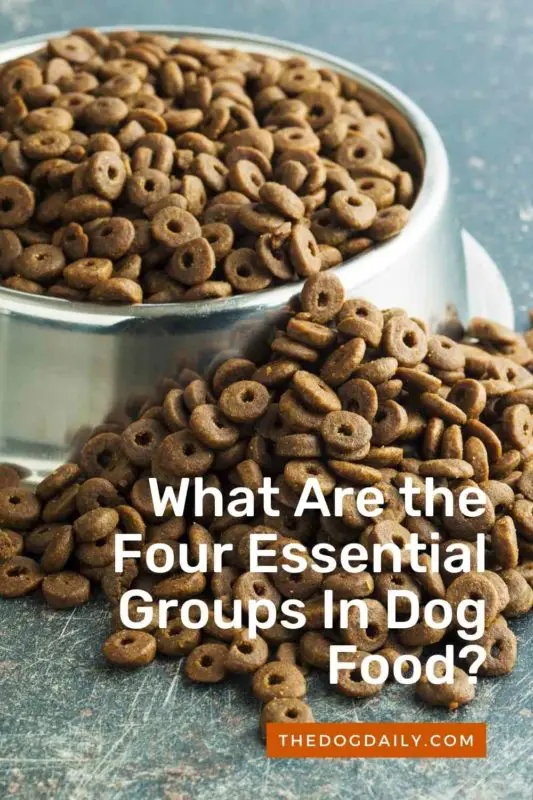What Are the Four Essential Groups In Dog Food?
Some commercial natural dog foods include more ingredients from the same food groups that people serve on the family dinner table. These groups have meats and other proteins and grains for carbohydrates, healthy fats for omega fatty acids, and vegetables and fruits for fiber.
“It may not be exactly how humans look at nutrition in terms of the food pyramid, but the four essential food groups that I think can apply to dogs and cats are; proteins, carbohydrates, fats, and fibers,” says Dr. Amy Dicke. Dr. Dicke is a Dayton, Ohio-based veterinarian who has worked with teams of nutritionists and researchers.
Key Ingredient Groups In Dog Food
As far as the family pets go, dogs and cats have very different nutritional requirements. “Dogs are much more along the lines of people in that they’re omnivores. They do well with a balanced diet with carbohydrates, fiber sources, and protein all mixed,” says Dr. Katy J. Nelson, an emergency veterinarian in Alexandria, Va., who has worked on dog nutrition.
Here are the main ingredient groups to look for in quality natural dog foods:
-
Proteins
At least one protein source should always be in a top spot on the ingredient label of dog food to meet regulatory standards from the Association of American Feed Control Officials (AAFCO) for a “complete and balanced” food for your dog. High-quality protein sources can include chicken, beef, lamb, and other meats, poultry, or fish. Also, by-products or meal from protein sources — such as chicken by-products or chicken meal — are also good sources of protein, says Dr. Joseph Wakshlag, assistant professor of clinical nutrition at the Cornell University School of Veterinary Medicine. “Just because you don’t like eating liver or think hearts are yucky doesn’t mean that by-products aren’t good-quality sources of protein,” he says. Organ meats are something that dogs would eat in the wild.
Protein helps to maintain muscle mass, which shows up in a dog’s posture. Dogs require the animal protein found in meats and meat by-products — including blood, internal organs, and bones, which are what dogs in the wild consumed. To evaluate whether a food has a high-quality protein source, consult your veterinarian or breeder.
“The first thing listed on the ingredient label of a dog’s food should be an animal protein,” says Dr. Nelson. The label should specify which animal the protein comes from, such as chicken or beef; the protein descriptor can be followed by the words “meal” or “by-product.”
-
Carbohydrates
For active dogs, carbohydrates can provide long and short bursts of energy, aid in digestion, and promote nutrient absorption. Good sources of carbohydrates include whole-grain sorghum, whole-grain barley, cornmeal, and rice, says Nelson. “Rice is good if you have an active dog that needs a short, quick burst of energy, but you need to have a backup carb source for your dog as well, or else once that wears off, your dog will be hungry again,” she adds. With its high glycemic index, rice provides a quick glucose and insulin spike that may be beneficial to working dogs, but a secondary carb source, which extends the energy curve, is useful for the run-of-the-mill house dog.
“As we all know from eating Chinese food and being hungry again two hours later, white rice causes a quick energy boost followed by a crash,” says Dr. Nelson. She recommends a food containing not only rice but also corn, barley, or sorghum. These ingredients have more moderate glycemic values that provide extended energy to keep your dog satiated all day.
-
Fatty Acids
According to Dicke, ingredients such as chicken fat and/or fish oil help your dog get critical fatty acids, like omega-3s and omega-6s. Fats can help a pup maintain skin and coat health, but fatty acids are vital in the brain and spinal cord function. “There has been documented evidence, especially among puppies, that having a diet higher in omega-3 DHA increases their ability to be trained,” says Dicke.
Together, omega-6s and omega-3s can help make the coat shiny and control inflammatory skin conditions that lead a dog to scratch and lick itself excessively. “You can tell a lot about a person’s health by looking at hair and skin, and dogs are no different,” says Dr. Nelson. “Skin and coat health are windows into what’s going on inside a dog. If they’re losing hair or have clogged pores, it may be a clue that something is lacking in their diet.”
-
Fiber
Fruits and vegetables, as well as other natural fiber sources, can help dogs maintain proper digestion. Ingredients such as apple and beet pulp combined with some grains and prebiotics like fructooligosaccharides (FOS) in premium foods can help your dog remain regular, says Dicke.
Scientific studies are also starting to support the benefits of adding some vegetables to your dog’s food. Researchers at Purdue University’s School of Veterinary Medicine found a 2005 study published in the Journal of the American Veterinary Medical Association. That study showed that when Scottish Terriers were fed vegetables at least three times per week, they had a lower incidence of developing a deadly type of bladder cancer called transitional cell carcinoma.
A protein is only as good as its digestibility. A dog requires a fiber that helps it to digest and thereby absorb the nutrients in its food. The fiber source also needs to help the dog remove waste from its intestines. Dr. Nelson recommends a food containing beet pulp (the substance that remains after sugar beets are pressed) because it doesn’t produce much gas and is moderately digestible, thus encouraging nutrient absorption.
Vitamins and Minerals
Of course, mammals do not live on protein, fiber, and carbohydrates alone; they also require vitamins and minerals to look and feel their best. Vitamin A is an antioxidant that squashes free radicals and gives your dog a healthy glow. Vitamin E works similarly while also promoting the strength of the nail and hair cuticle. Copper further aids in the absorption of nutrients crucial to your pet’s appearance and overall health.
Dr. Nelson suggests checking the ingredients label on dog food bags to ensure they contain all of them. You can even visually detect if your dog is getting adequate nutrition. “When you see a dog on high-quality food, you recognize it immediately,” she says. “Balanced nutrition shows up outwardly.”
Before making any dietary changes for your dog, always talk to your veterinarian. “There are a lot of great foods out on the market, but some may not be great for your particular dog,” says Nelson. “Before you change the protein source or carbohydrate source, call your veterinarian and say, ‘I’m thinking of doing this. Is it good food? Is it OK for my particular pet?'”
Article written by Author: Elizabeth Wasserman and Darcy Lockman

